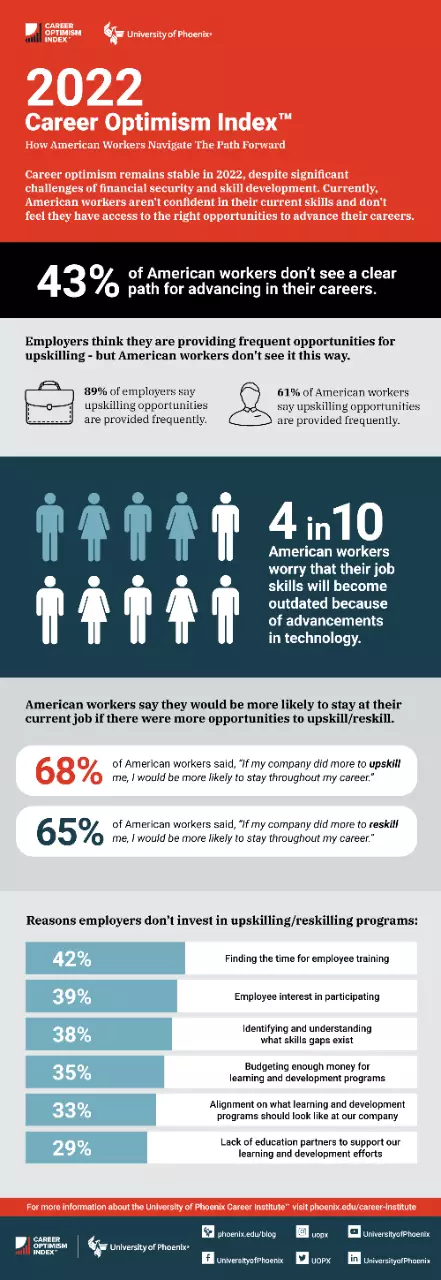A new normal: The job outlook for 2022

Written by Elizabeth Exline

Reviewed by Jessica Roper, MBA, director of Career Services at °®ÎŰ´«Ă˝

Job outlook for 2022
Have you changed jobs in the past two years? Been recruited? Quit without having another job lined up, or just regularly scanned available jobs? Have you upskilled with a certificate or even a degree?
Given the state of the job market in 2022, chances are good that you answered yes to at least one of the above. That’s because, while trends aplenty have cropped up over the past year (and we’ll get to them soon), three of them seem to dominate the landscape:
- It’s an employee’s world. We just work in it. The labor shortage means workers can call the shots to some degree. And what they want more than money or benefits is work-life balance.
- Healthcare continues to be the golden child of the post-pandemic job market. It was always true that healthcare jobs were readily available. It’s even truer today.
- DEIB is more than just the abbreviation of the moment. It has spurred a proliferation of human resources jobs that aren’t going anywhere soon. (For the uninitiated, DEIB stands for diversity, equity, inclusion and belonging.)
With a wealth of data available on how the workplace is growing out of its pandemic-induced constraints, we’re digging into the latest job outlook and trends as well as how to best ensure you’re ready for what’s ahead.
Job outlook for growing careers
The U.S. Bureau of Labor Statistics (BLS) couldn’t have predicted the COVID-19 pandemic, but it pulled together enough data by September 2021 to issue a rather insightful release titled .
To offer a comprehensive picture of the job market, the document accounts for recovery growth as well as non-pandemic-related growth.
The winners
- The healthcare and social assistance sector will add the most new jobs. Healthcare support occupations are projected to have the fastest job growth among occupational groups. (Examples of healthcare support roles include home health aides and occupational therapy assistants.)
- Within healthcare, jobs in individual and family services are projected to increase the fastest, largely due to an aging baby-boom population, longer life expectancies and a growing number of patients with chronic conditions.
- The industry with the fastest projected growth is leisure and hospitality, but it’s fueled by pandemic recovery. (All those hotels, restaurants, cultural icons and recreational destinations you haven’t visited in two years? Neither has anyone else — and they’re ready to now.)
- Employment growth in professional, business and scientific services (including computer systems, design and related services) are projected to grow 2.1% each year, while management, scientific and technical consulting services are projected to grow 2% each year.
The losers
- Employment in retail trade is projected to lose nearly 600,000 jobs between 2020 and 2030, likely as a result of pandemic-induced spending patterns.
- The labor force is projected to decline from 61.7% in 2020 to 60.4% in 2030 due to an aging baby-boom generation and an overall decline in participation.
The interpretation
This data corroborates what °®ÎŰ´«Ă˝ career advisor Ricklyn Woods has seen firsthand. Healthcare may continue to attract students, she says, but many of those graduates are seeking nonclinical roles.
“There are a lot of people who want to study healthcare, but they don’t necessarily want to be patient-facing,” Woods explains.
She points to roles in insurance, billing, pharmaceutical research and health administration as increasingly attractive.Â
Another trend? Technology.
For anyone born after 1990, there was indeed a time when choosing a field of study in anything but technology meant that you didn’t need to learn technology.
Those days are over.
Today, technology is integrated into virtually every field, from human resources to healthcare.
“No matter what you’re doing, you need to be able to know how to navigate technology and systems; otherwise, you’ll be left behind,” Woods says.
By way of example, she points to a client who had 20 years of experience in healthcare administration. The employee was ready to move to a bigger practice, but she lacked the technological skills bigger organizations required, making the transition difficult without upskilling.
Jobs on the rise, according to LinkedIn®
BLS isn’t the only organization collating data on the state of the job market. LinkedIn compiled its own for 2022 based on job titles that had the highest growth rates between January 2017 and July 2021. According to the report, jobs in healthcare are indeed having a moment (“vaccine specialist” tops the chart), but they’re not the only ones. Roles in human resources and DEIB are on the rise too.
LinkedIn is a registered trademark of LinkedIn Corporation and its affiliates in the United States and/or other countries.
Other highlights include:
- Roles in marketing continue to grow, particularly those influenced by or directly associated with IT. (Think customer and search marketing manager roles and analyst relations specialists.)
- Technology roles are proliferating. Positions like machine learning engineer, user experience researcher, business system administrator, back-end developer, customer solutions engineer and site reliability engineer all made the list.
- People matter. Three of the list’s 25 roles were in human resources, with the position of diversity and inclusion manager taking the second highest spot.Â
Career optimism by the numbers
In 2022, °®ÎŰ´«Ă˝ commissioned its second Career Optimism Index to assess how American workers felt about their jobs and the employment landscape in general. The survey includes responses from 5,000 adults who are working or wish to be working, as well as 500 employers.
The results are extensive, but some key highlights are:
- 52% of Americans are either looking for a job or planning to look in the next six months.
- Almost one-third of workers say they’d quit their job without having another one lined up.
- 90% of employers cite talent retention as a priority.
- That retention might be easier if compensation were higher: 44% of Americans are unsatisfied with their salaries; 30% feel their salaries are downright unfair.
- The number of Americans living paycheck to paycheck rose from 43% to 56% between 2021 and 2022.
- Remember that need to upskill? A whopping 89% of employers say those opportunities are there, but only 61% of employees seem to see them.
- 40% of Americans say the pandemic has derailed their careers, that’s up from 34% in 2021.
- Love your job? Not quite. 85% of employers say employees love their jobs. Ask the employees, and that number drops to 66%.
- Has work-life balance improved? Yes: 93% of employers say employees have it, and 81% of employees agree.
Beyond the job: 6 trends to watch
So, what do all these numbers mean? recently assessed the same reports from BLS and LinkedIn to identify the following trends:
- The tight labor market is likely to continue through 2030 unless the economy changes or automation expands unexpectedly.
- In 2021, it was the year of the so-called boomerang employee: a person who left a job during the pandemic only to return (or want to return) to their old employer soon thereafter.
- Burnout is real for healthcare workers, which makes those non-patient-facing roles Woods cited extra attractive.
- There’s a growing emphasis on building more inclusive workforces.
- Work-life balance tops the wish list of most employees, trumping even compensation and benefits.
- Remote work isn’t going anywhere. In fact, there’s been an 83% increase in job posts on LinkedIn that mention flexibility since 2019.
How to prepare for change
While employers and employees may not see eye to eye on what opportunities for upskilling are available, they do agree that continued education is important.
“You have to keep learning, and it doesn’t just stop with the culmination of a degree,” Woods says.
That can be a hard thing to hear, especially if you’ve recently completed a degree program. But upskilling doesn’t have to be intimidating. Woods offers the following tips for staying up to date in your field:
- Join industry-specific associations. Not only will you soak up insights and information from a community of peers, you might even find a mentor — or your next opportunity. “A lot of jobs are based on who you know,” Woods points out. “That’s old school, but it still applies today.
- Attend webinars. One silver lining of social distancing? Conferences are more accessible than ever.
- Explore certifications and certificates. Professional development keeps you sharp.
If investing time and money in your career gives you pause, you’re not alone. Plenty of people wait for their employers to foot the bill for a class, a course or even a degree, Woods notes. But there’s another way to look at the situation.
“Taking ownership of your own career development through ongoing professional development is an investment,” Woods acknowledges. “But it’s an investment that, if you plan strategically, you should be able to see a return on.”
Additional career resources
When it’s time to actively search for a new job, use the downloadable resources below, which cover the two pillars of any job search: writing an effective resumé and drafting a powerful cover letter.

ABOUT THE AUTHOR
Elizabeth Exline has been telling stories ever since she won a writing contest in third grade. She's covered design and architecture, travel, lifestyle content and a host of other topics for national, regional, local and brand publications. Additionally, she's worked in content development for Marriott International and manuscript development for a variety of authors.

ABOUT THE REVIEWER
Jessica Roper, °®ÎŰ´«Ă˝ director of Career Services, is a seasoned leader with over 15 years of experience in leadership within higher education. She has honed her expertise in student services and career development and is passionate about helping others discover and refine their skills.
This article has been vetted by °®ÎŰ´«Ă˝'s editorial advisory committee.Â
Read more about our editorial process.
Read more articles like this:





